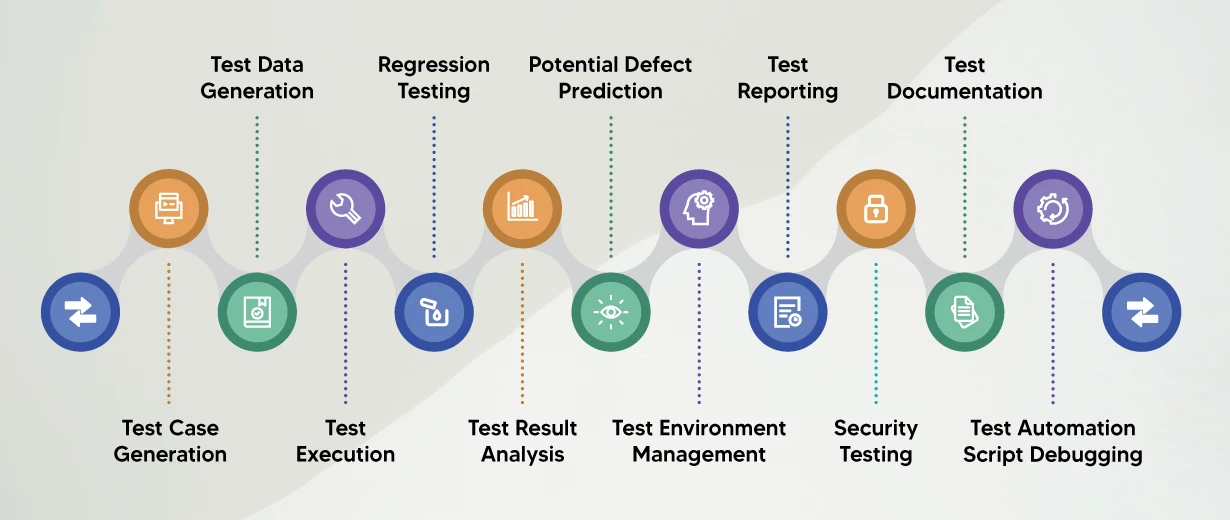Other recent blogs



Let's talk
Reach out, we'd love to hear from you!
Amid the rise of automated software quality assurance, Generative Artificial Intelligence (AI) is becoming mainstream in the software testing landscape. Generative AI-enabled quality assessment can be explained as a new way forward to drive greater performance and better accuracy by automating many tasks involved in manual testing and quality assurance lifecycle.
According to the report published on DBMR, the automation testing market is growing significantly at a CAGR of 17.06% and is expected to reach USD 93.6 billion by 2032. The deeper penetration of rapid Generative AI-enabled technologies in software quality engineering is revolutionizing the fundamental way we conduct manual testing. It foster as a deeper human-algorithm symphony under the umbrella of machine learning (ML), deep learning (DL), and natural language processing (NLP) by solving the most pressing challenges faced by software quality assurance (QA) teams, including

Generative AI in software testing: Uncovering untold benefits of next-level QA approach
Manual testing presents many existential challenges in the quality assurance lifecycle, which consequently lead to errors, testing gaps, limited coverage, and long-running laborious tests. Putting Generative AI at the center of the QA process accelerates the pace of business innovation through the early detection of patterns, anomalies, and vulnerabilities in software, as well as the prediction of potential issues. Its widespread adoption streamlines quality assurance efforts by providing comprehensive test coverage, managing risks, improving quality quotient, and reducing operational overhead – all while ensuring quality and adhering to best practices.
AI-enabled quality engineering process provides greater data control by striking the right balance of automated and manual quality analysis across the software development workflows. It helps QA experts to focus more on complex and critical tasks, including exploratory testing and root cause analysis.
Here's a more concise breakdown. Generative AI fundamentally transforms the manual testing and quality assessment process in several impactful ways:
- Test planning:
Generative AI plays a crucial role in software test planning by providing QA engineers with valuable insights. It helps testing engineers find best tools to analyze their specific testing requirements and recommend a comprehensive suite of testing tools.
Also, Generative AI enables manual testers to identify potential risks early including compatibility issues and domain benchmarks, by analyzing historical data, code metrics, and project specifications in the initial planning phase.
Embracing Generative AI in software testing also helps in automating device metrics while ensuring a comprehensive testing across various devices, operating systems, and browsers with greater precision beyond human capabilities.
- RTM and test case scenario generation:
In every SDLC, an effective quality assessment process is crucial to analyze the performance of a particular application, software, or module. To monitor whether the product is working properly as per the specific metrics, QA experts leverage Requirement Traceability Matrix (RTM) to map and trace specific user requirement with different relevant test cases/scenarios, and test datasets. According to Gartner, approximately 20% of test data used for consumer-facing applications will be synthetic by 2025. In the product testing landscape, QA experts use datasets to evaluate a product application's functionality, and other aspects during SDLC under diverse possible scenarios.
Generative AI plays a transformative role, especially in data-intensive applications, by generating synthetic outputs mirroring real-world scenarios with zero compromises on data privacy or security fronts. It enables QA engineers to proactively address potential pitfalls and optimizes the entire test case generation workflow by automatically generating relevant test cases to cover multiple scenarios and edge cases.

Also, using Generative AI in quality assurance, manual testers create simulating test case information grounded on multiple data inputs and patterns at the lower and upper limits to rigorously test the product's functionalities. This helps identify the software's performance with different inputs, ultimately leading to more robust and reliable applications. Greater accuracy, early detection of critical bugs in the SDLC, increased test coverage, boundary value analysis, and edge case identification.
Manual test data generation is prone to human errors. To achieve maximum accuracy, manual testers are taking the help of Generative AI for
- Data masking and privacy by using synthetic test data, which resembles real-world datasets to a greater extent. However, the synthetic datasets are anonymized or pseudonymized in compliance to data privacy regulations like GDPR. As a result, QA experts are able to execute rigorous tests with zero exposure to sensitive information.
- Data variability as AI enables them to leverage diverse test datasets, which cover different data types, ranges, and conditions in particular.
- Data validation for enhanced consistency and integrity of test datasets created to adhere to predefined constraints and business rules.
- Data corruption testing wherein the QA team uses AI to deliberately corrupt test data and monitor the product's performance in unfavorable scenarios.
- Load and performance testing by putting large datasets (created using Generative AI) under the radar to simulate real-world loads and validate the performance under stress.
By streamlining the test data generation process, Generative AI helps manual testers test the system more thoroughly and identify potential bugs faster.
- Enhanced test coverage:
Test cases are the backbone of every quality assessment process by defining the expected product behaviors under stress and responding correctly to changing software requirements and environments. Generative AI brings a fresh perspective to test case creation by addressing gaps in test coverage before a product is released.
Enhanced quality assessment workflow powered by Generative AI includes
- Functional coverage wherein AI automates all types of mundane and repetitive testing functions and provide maximum test coverage in accordance to functional requirements and specifications of a software system. Generative AI-enabled automated testing results in greater accuracy, improved test data management, and enhanced quality of testing.
- Path coverage by validating each and every possible line of code, and sequence of code executed thoroughly across the product development lifecycle software. Generative AI enables QA experts to keep every probability of failure behind by streamlining complex code generation and script writing process in according to a relevant scenario. Comprehensive code coverage, maximum code paths reliability, reduced redundant tests and improved software quality are potential benefits of path coverage using AI.
- Boundary coverage and value analysis by providing maximum test coverage. Generative AI enables QA experts predict potential boundary values, handle large volumes of data and identify possible errors at boundary cases. It happens when QA experts test a numerous range of input values with limited test cases, resulting in increased efficiency, better accuracy and software reliability, and improved user experience.
Embracing Generative AI for enhanced test coverage plays a crucial role in testing the application's performance under various conditions and identifying every possible bottleneck as well as scalability issues. Additionally, by suggesting additional test scenarios, AI helps in comprehensive quality assessment and robust testing in real-world usage.
- Script writing and automation:
Automation is a cornerstone of modern software testing. Generative AI offers an innovative approach to script writing, making it easier to automate various testing activities, irrespective of the programming language used.
Generative AI can automate the creation of testing scripts, reducing the manual effort required for scripting and making it language-agnostic. This not only saves time but also minimizes human errors in script development, enhancing the accuracy of tests. Another benefit is maximum code coverage wherein the actual source code is executed during data testing to ensure that every line of code is rigorously tested, including branches, loops, and conditional statements.
It can analyze application flows and automatically generate testing scripts tailored to specific functionalities. This minimizes the need for manual scripting and reduces the risk of human errors. Also, it is leveraged to generate testing scripts for applications developed in various programming languages. This flexibility is invaluable in heterogeneous development environments.
- Continuous integration and deployment (CI/CD):
Generative AI equips QA engineers with the right approach for setting-up an error-free continuous integration and continuous deployment (CI/CD) process. By embracing the Generative-AI enabled quality assurance practice in software testing lifecycle, QA engineers get access to a much-needed roadmap plan with a clear direction and a set of actionable steps that helps them optimize the testing and deployment procedures faster, leading to faster release cycles and improved software quality.
Win automation testing and quality engineering game with Kellton
Recent Generative AI developments in the quality assurance and manual testing landscape have put organizations on the cusp of a new automation age where CEOs are on the verge of reaping AI-enabled quality assurance’s full potential. However, its success predominantly depends on the organization’s capabilities to navigate standard automation testing-related challenges such as maintaining and scaling test automation frameworks, lack of resources, and integration with the DevOps pipeline.
As an industry leader in software quality assurance and AI-driven automation testing, Kellton helps companies unlock continuous delivery and increase their test coverage. We strike the right balance of automated and manual quality analysis (QA) workflows to optimize product performance with greater consistency in test quality and accelerate end-to-end responsiveness across the quality assurance lifecycle.
At Kellton’s well-equipped Center of Excellence, our team leverages its cutting-edge quality engineering expertise at the intersection of state-of-the-art QA frameworks, testbeds, tools, and resolution devices to seamlessly fix potential issues. This way, we ensure incremental development, reduced time-to-market, faster deployment, and facilitate greater agility to meet product volatilities while improving defect detection accuracy.



